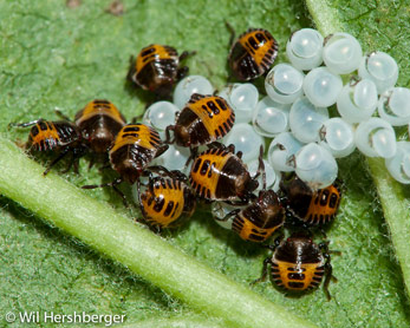|
Synopsis for Dr. Dilip Venugopal’s colloquium talk, “Spatial heterogeneity of stink bug (Hemiptera: Pentatomidae) populations in agricultural systems” This week’s colloquium again focused on the brown marmorated stink bug (BMSB). While BMSB is best known for terrorizing area residents in their homes, BMSB also feeds on a wide range of plants and is a major agricultural pest of field crops, fruit, vegetables, and ornamentals. In the exciting conclusion to this semester’s colloquium series, Dr. Dilip Venugopal presented his findings from extensive research on the BMSB in mid-Atlantic field crops. Dr. Venugopal’s work focused on understanding the spatial patterns of stink bug population dynamics. He conducted extensive field surveys to examine these patterns at various spatial scales, which included localized portions of agriculture plots, whole crop fields and the mid-Atlantic region. Dr. Venugopal’s research illustrates the roles of landscape and environment in facilitating the outbreak and spread of stink bugs. In his initial study, Dr. Venugopal analyzed stink bug density and crop damage along the edges of corn and soy fields. Dramatically, his team found a majority of stink bugs in these fields were BMSB (97% and 93% on corn and soybean plants, respectively). BMSB densities were also higher adjacent to woods compared to open areas. This difference was likely because BMSB moved into crops from tree hosts in the woods and, upon settling in the crops, laid their eggs in the field edge. The small nymphs do not travel far after hatching. Additionally, Asian trees found in adjacent woods, such asAilanthus and Paulownia, were common hosts for the BMSB, an Asian native. Regarding crop damage, both corn and soy experienced a loss in quality while only soy had lesser yields as a result of feeding. Following the edge survey, the next focus studied the spatiotemporal distributions of stink bug distribution in a field. Dr. Venugopal hypothesized that as corn matures, stink bugs would migrate to soy fields. He found that there was a stage structure difference between the two crops. While small nymphs were primarily found on corn, large nymphs and adults were found on the soy plants. Data also revealed BMSB preferred plants with fruiting bodies (ears of corn or soy bean pods) over those without, particularly the milk and dough stages in corn and pod filling stages in soybean. The movement of large nymphs and adults to the soy is likely due to the nutritional quality of the plants. Bugs favor higher sugar and nitrogen content and BMSB migrated from corn into soy when it was most nutritious. The final aim of his research was to gain an understanding of the spatial heterogeneity across a larger regional scale. Collaborating with researchers from Virginia Tech and University of Delaware, Dr. Venugopal compiled data from 208 soybean fields across 4 states (Delaware, Maryland, Virginia, and West Virginia). He analyzed 45 temperatures, environmental, and land use variables to determine what was driving patterns in stink bug abundance across the region. The methods used for analyzing the spatial patterns can be found here. Results showed that the influence of adjacent habitat was limited to within fields, and that temperature and urbanized regions were the primary factors structuring BMSB abundance patterns across mid-Atlantic region. The main difference between BMSB and other native stink bugs was its association with urban zones, while the native species were associated with forested areas. Based on his findings, Dr. Venugopal concluded the placement and arrangement of crops are important to reducing stink bug outbreaks. Dr. Venugopal recommends the avoidance of shared boundaries of corn and soybeans. Planting times should be considered with an aim to break the synchrony of crop stages. Finally, the high density of stink bugs along field edges makes insecticide treatment of entire fields unnecessary. Instead, insecticide applications could be reduced by limiting treatment to edges only, particularly those bordering woods. Once considered a secondary agriculture pest, stink bugs have gained increased attention due to the recent introduction of the brown marmorated stink bug. The economic importance of this pest cannot be understated. Last year this bug caused an estimated $73 million in damage to soybean crops across 11 states. Dr. Venugopal research is as a much needed driver advocating necessary changes in crop and pest management practices. About Kevin:
Kevin Ulrich is a PhD candidate in the Thorne Lab. His current research involves host-pathogen relationships and how natural controls can best be utilized in urban environments using Cimex lectularius, the common bed bug, as a model organism. This research is aimed at reducing chemical pesticide reliance in favor of greener and safer alternatives. About Erik: Erik Bergmann is a third year masters student in Michael Raupp’s lab conducting research on patterns of host use by BMSB in woody ornamental plant species. He is graduating in August and will be joining Bartlett Tree Experts in June. About Becca: Becca Wilson is a first year masters student in Bill Lamp’s lab. She is currently studying the distribution patterns of nuisanceblack flies in Washington County, Maryland. Comments are closed.
|
Categories
All
Archives
June 2024
|
Department of Entomology
University of Maryland
4112 Plant Sciences Building
College Park, MD 20742-4454
USA
Telephone: 301.405.3911
Fax: 301.314.9290
University of Maryland
4112 Plant Sciences Building
College Park, MD 20742-4454
USA
Telephone: 301.405.3911
Fax: 301.314.9290



 RSS Feed
RSS Feed




